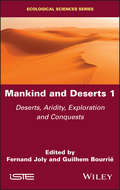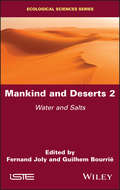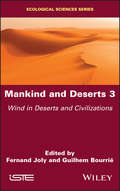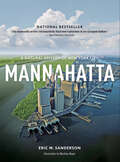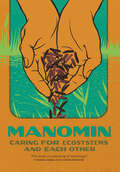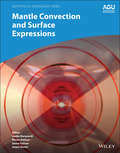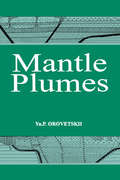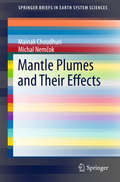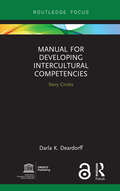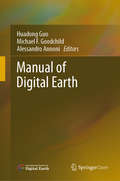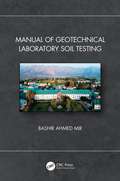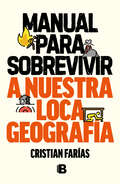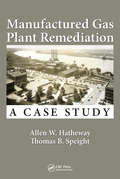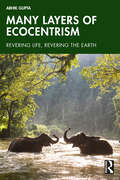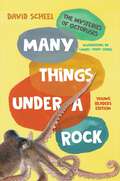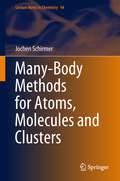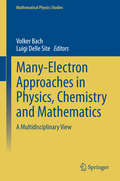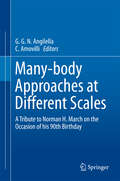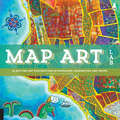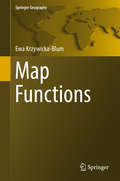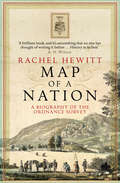- Table View
- List View
Manifolds, Tensors, and Forms
by Paul RentelnProviding a succinct yet comprehensive treatment of the essentials of modern differential geometry and topology, this book's clear prose and informal style make it accessible to advanced undergraduate and graduate students in mathematics and the physical sciences. The text covers the basics of multilinear algebra, differentiation and integration on manifolds, Lie groups and Lie algebras, homotopy and de Rham cohomology, homology, vector bundles, Riemannian and pseudo-Riemannian geometry, and degree theory. It also features over 250 detailed exercises, and a variety of applications revealing fundamental connections to classical mechanics, electromagnetism (including circuit theory), general relativity and gauge theory. Solutions to the problems are available for instructors at www. cambridge. org/9781107042193.
Mankind and Deserts 1: Deserts, Aridity, Exploration and Conquests
by Guilhem Bourrié Fernand JolyThe wild beauty of deserts has always been a source of fascination the world over. Mankind and Deserts 1 – the first of three volumes – describes their location and geographic variety. There are both hot and cold deserts, those at high altitude or those at sea level, differing in climate but sharing the scarcity of water, extreme temperatures and often violent winds. According to paleoclimate evidence, however, deserts have not always been as arid as they are today. Deserts were a source of inspiration for many spiritual leaders, among them, Moses, Jesus and Muhammad; as well as conquerors, from Alexander the Great to Genghis Khan. Some avoided these deserts, or crossed them as fast as they could. Others adapted to them and developed vibrant civilizations and cities. From ancient, almost mythical, exploration to modern scientific studies, deserts have come to be better known yet still hold great appeal. This book traces the history of their knowledge while providing a basis for understanding their features and the tools needed for their protection, in an ever-changing world.
Mankind and Deserts 2: Water and Salts
by Guilhem Bourrié Fernand JolyThe wild beauty of deserts has always been a source of fascination the world over. Mankind and Deserts 2 – the second of three volumes – focuses on water, its absence or indeed its extreme scarcity, as well as on the ways in which salts come to be formed in areas such as these. Aridity of the climate does not exclude rainfall, after which deserts flourish; wet mists, dew, exceptional events separated by years of total drought. Water flows into temporary and disorganized networks but, occasionally, large rivers cross the deserts, giving rise to vibrant civilizations: the Nile, Tigris and Euphrates, Niger, to name a few. Temporary or permanent lakes collect water in basins without outlet to the ocean, referred to as endorrheic basins, such as Lake Chad. This results in salt accumulation and evaporitic formations. A large variety of salts crystallize, in addition to halite, among which is potash. Halite – common salt – is an essential resource and its trade leads to the creation of salt caravans, used to exchange it with gold, even on a 1-1 weight basis, generating subsequent wealth. From ancient, almost mythical, exploration to modern scientific studies, deserts have come to be better known yet still hold great appeal. This book traces the history of their knowledge while providing a basis for understanding their features and the tools needed for their protection, in an ever-changing world.
Mankind and Deserts 3: Wind in Deserts and Civilizations
by Guilhem Bourrié Fernand JolyThe wild beauty of deserts has always been a source of fascination the world over. Mankind and Deserts 3 – the third and final volume – focuses on wind, frequently present in all deserts, either hot or cold. Wind plays a major role in aridity and landscapes bear numerous forms due to its action, erosion, transportation and surface formations, some discreet and others spectacular, such as vast expanses of towering yardangs. Aeolian dynamics lead to dune formation, simple or associated with sand ridges or ergs, as in the Sahara. Mankind has attempted, to varying degrees of success, to cope with sand accumulation; ignoring aeolian dynamics has led many development projects to failure. This is developed by Yann Callot, a Professor at Lyon University who studied aeolian dynamics in the Sahara. Traditional societies have adapted to live in deserts, establishing vibrant civilizations with original ways of living, managing water resources and creating routes for trade, especially for salt. In a changing environment, useful lessons can be drawn from the genius of mankind's adaptation to such diverse and fragile environments. This is explained by Marc Côte, who was a Professor at Constantine (Algeria) and Aix-en-Provence Universities. From ancient, almost mythical, exploration to modern scientific studies, deserts have come to be better known yet still hold great appeal. This book traces the history of their knowledge while providing a basis for understanding their features and the tools needed for their protection, in an ever-changing world.
Mannahatta: A Natural History of New York City
by Eric W. SandersonWhat did New York look like four centuries ago? An extraordinary reconstruction of a wild island from the forests of Times Square to the wetlands downtown. Named a Best Book of the Year by Library Journal, New York Magazine, and San Francisco Chronicle On September 12, 1609, Henry Hudson first set foot on the land that would become Manhattan. Today, it&’s difficult to imagine what he saw, but for more than a decade, landscape ecologist Eric Sanderson has been working to do just that. Mannahatta: A Natural History of New York City is the astounding result of those efforts, reconstructing in words and images the wild island that millions now call home. By geographically matching an eighteenth-century map with one of the modern city, examining volumes of historic documents, and collecting and analyzing scientific data, Sanderson re-creates topography, flora, and fauna from a time when actual wolves prowled far beyond Wall Street and the degree of biological diversity rivaled that of our most famous national parks. His lively text guides you through this abundant landscape—while breathtaking illustrations transport you back in time. Mannahatta is a groundbreaking work that provides not only a window into the past, but also inspiration for the future. &“[A] wise and beautiful book, sure to enthrall anyone interested in NYC history.&” —Publishers Weekly (starred review) &“A cartographical detective tale . . . The fact-intense charts, maps and tables offered in abundance here are fascinating.&” —The New York Times &“[An] exuberantly written and beautifully illustrated exploration of pre-European Gotham.&” —San Francisco Chronicle &“You don&’t have to be a New Yorker to be enthralled.&” —Library Journal
Manomin: Caring for Ecosystems and Each Other
by Brittany Luby Jane Mariotti Samantha Mehltretter Andrea Bradford Niisaachewan Anishinaabe Nation Dani KasteleinReclaiming crops and culture on Turtle Island Manomin, more commonly known by its English misnomer “wild rice,” is the only cereal grain native to Turtle Island (North America). Long central to Indigenous societies and diets, this complex carbohydrate is seen by the Anishinaabeg as a gift from Creator, a “spirit berry” that has allowed the Nation to flourish for generations. Manomin: Caring for Ecosystems and Each Other offers a community-engaged analysis of the under-studied grain, weaving together the voices of scholars, chefs, harvesters, engineers, poets, and artists to share the plant’s many lessons about the living relationships between all forms of creation. Grounded in Indigenous methodologies and rendered in full colour, Manomin reveals and examines our interconnectedness through a variety of disciplines—history, food studies, ethnobotany, ecology—and forms of expression, including recipes, stories, and photos. A powerful contribution to conversations on Indigenous food security and food sovereignty, the collection explores historic uses of Manomin, contemporary challenges to Indigenous aquaculture, and future possibilities for restoring the sacred crop as a staple. In our time of ecological crisis, Manomin teaches us how to live well in the world, sustaining our relations with each other, our food, and our waterways.
Mantle Convection and Surface Expressions (Geophysical Monograph Series)
by Hauke Marquardt Maxim Ballmer Sanne Cottaar Jasper KonterA multidisciplinary perspective on the dynamic processes occurring in Earth's mantle The convective motion of material in Earth's mantle, powered by heat from the deep interior of our planet, drives plate tectonics at the surface, generating earthquakes and volcanic activity. It shapes our familiar surface landscapes, and also stabilizes the oceans and atmosphere on geologic timescales. Mantle Convection and Surface Expressions brings together perspectives from observational geophysics, numerical modelling, geochemistry, and mineral physics to build a holistic picture of the deep Earth. It explores the dynamic processes occurring in the mantle as well as the associated heat and material cycles. Volume highlights include: Perspectives from different scientific disciplines with an emphasis on exploring synergies Current state of the mantle, its physical properties, compositional structure, and dynamic evolution Transport of heat and material through the mantle as constrained by geophysical observations, geochemical data and geodynamic model predictions Surface expressions of mantle dynamics and its control on planetary evolution and habitability The American Geophysical Union promotes discovery in Earth and space science for the benefit of humanity. Its publications disseminate scientific knowledge and provide resources for researchers, students, and professionals.
Mantle Convection for Geologists
by Geoffrey F. DaviesMantle convection is the fundamental agent driving many of the geological features observed at the Earth's surface, including plate tectonics and plume volcanism. Yet many Earth scientists have an incomplete understanding of the process. This book describes the physics and fluid dynamics of mantle convection, explaining what it is, how it works, and how to quantify it in simple terms. It assumes no specialist background: mechanisms are explained simply and the required basic physics is fully reviewed and explained with minimal mathematics. The distinctive forms that convection takes in the Earth's mantle are described within the context of tectonic plates and mantle plumes, and implications are explored for geochemistry and tectonic evolution. Common misconceptions and controversies are addressed - providing a straightforward but rigorous explanation of this key process for students and researchers across a variety of geoscience disciplines.
Mantle Plumes
by Yu P. OrovetskiiSeveral aspects of interpretation of geophysical data applied to the study of tectonics, geodynamics, metamorphism and magmatism are discussed. Deep-level geophysical data has revealed a new class of physical inhomogeneities in the lithosphere of various regions of diverse ages around the world.
Mantle Plumes and Their Effects
by Michal Nemčok Mainak ChoudhuriThis book presents a brief synopsis of the current academic understanding of the plume hypothesis, its surface manifestations and its shortcomings. It also describes methods for estimating the uplift history of a region due to plume activity. It discusses different models for the elastic properties of the lithosphere and their estimation as a background for plume emplacement, and introduces the plume hypothesis, describing the major plume types and their effect on the lithosphere. Two chapters are dedicated to the dynamic and permanent topography produced by an impinging plume head below the lithosphere and its estimation. It also presents the historical background of the plume hypothesis, its criticisms and alternatives.
Manual for Developing Intercultural Competencies: Story Circles (Routledge Focus on Environment and Sustainability)
by Darla K. DeardorffThis book presents a structured yet flexible methodology for developing intercultural competence in a variety of contexts, both formal and informal. Piloted around the world by UNESCO, this methodology has proven to be effective in a range of different contexts and focused on a variety of different issues. It, therefore can be considered an important resource for anyone concerned with effectively managing the growing cultural diversity within our societies to ensure inclusive and sustainable development. Intercultural competence refers to the skills, attitudes, and behaviours needed to improve interactions across difference, whether within a society (differences due to age, gender, religion, socio-economic status, political affiliation, ethnicity, and so on) or across borders. The book serves as a tool to develop those competences, presenting an innovative adaptation of what could be considered an ancient tradition of storytelling found in many cultures. Through engaging in the methodology, participants develop key elements of intercultural competence, including greater self-awareness, openness, respect, reflexivity, empathy, increased awareness of others, and in the end, greater cultural humility. This book will be of great interest to intercultural trainers, policy makers, development practitioners, educators, community organizers, civil society leaders, university lecturers and students – all who are interested in developing intercultural competence as a means to understand and appreciate difference, develop relationships with those across difference, engage in intercultural dialogue, and bridge societal divides.
Manual of Digital Earth
by Michael F. Goodchild Huadong Guo Alessandro AnnoniThis open access book offers a summary of the development of Digital Earth over the past twenty years. By reviewing the initial vision of Digital Earth, the evolution of that vision, the relevant key technologies, and the role of Digital Earth in helping people respond to global challenges, this publication reveals how and why Digital Earth is becoming vital for acquiring, processing, analysing and mining the rapidly growing volume of global data sets about the Earth. The main aspects of Digital Earth covered here include: Digital Earth platforms, remote sensing and navigation satellites, processing and visualizing geospatial information, geospatial information infrastructures, big data and cloud computing, transformation and zooming, artificial intelligence, Internet of Things, and social media. Moreover, the book covers in detail the multi-layered/multi-faceted roles of Digital Earth in response to sustainable development goals, climate changes, and mitigating disasters, the applications of Digital Earth (such as digital city and digital heritage), the citizen science in support of Digital Earth, the economic value of Digital Earth, and so on. This book also reviews the regional and national development of Digital Earth around the world, and discusses the role and effect of education and ethics. Lastly, it concludes with a summary of the challenges and forecasts the future trends of Digital Earth. By sharing case studies and a broad range of general and scientific insights into the science and technology of Digital Earth, this book offers an essential introduction for an ever-growing international audience.
Manual of Geotechnical Laboratory Soil Testing
by Bashir Ahmed MirManual of Geotechnical Laboratory Soil Testing covers physical, index, and engineering properties of soils, including compaction characteristics (optimum moisture content), permeability (coefficient of hydraulic conductivity), compressibility characteristics, and shear strength (cohesion intercept and angle of internal friction). Further, this manual covers data collection, analysis, computations, additional considerations, sources of error, precautionary measures, and the presentation results along with well-defined illustrations for each of the listed tests. Each test is based on relevant standards with pertinent references, broadly aimed at geotechnical design applications. FEATURES Provides fundamental coverage of elementary-level laboratory characterization of soils Describes objectives, basic concepts, general understanding, and appreciation of the geotechnical principles for determination of physical, index, and engineering properties of soil materials Presents the step-by-step procedures for various tests based on relevant standards Interprets soil analytical data and illustrates empirical relationship between various soil properties Includes observation data sheet and analysis, results and discussions, and applications of test results This manual is aimed at undergraduates, senior undergraduates, and researchers in geotechnical and civil engineering. Prof. (Dr.) Bashir Ahmed Mir is among the senior faculty of the Civil Engineering Department of the National Institute of Technology Srinagar and has more than two decades of teaching experience. Prof. Mir has published more than 100 research papers in international journals and conferences; chaired technical sessions in international conferences in India and throughout the world; and provided consultancy services to more than 150 projects of national importance to various government and private agencies.
Manual para sobrevivir a nuestra loca geografía
by Cristián FaríasDe norte a sur, la mirada del geofísico Cristian Farías sobre los eventos naturales que azotan nuestra geografía y que provocan, por fallas humanas, aquello que llamamos "desastre". ¿Por qué se sigue edificando en la zona costera que eventualmente puede ser asolada por un tsunami? ¿Por qué los chilenos no tenemos plena conciencia de que nos recorren volcanes de norte a sur y que pueden hacer erupción en cualquier momento, cerca, por ejemplo, de Pucón? El geofísico Cristian Farías nos orienta sobre placas tectónicas que se "pelean" y provocan desastres, y revisa en cada caso por qué ocurrió ese desastre, dónde estuvieron los problemas, e intenta una suerte de estrategia para definir de qué manera vamos a arreglarlo para que no nos pase de nuevo.
Manufactured Gas Plant Remediation: A Case Study
by Allen W. Hatheway Thomas B. SpeightThe assessment, remediation, and redevelopment of manufactured gas plant (MGP) sites pose a significant technical and financial challenge to successor property owners, including municipalities and other public entities undertaking brownfields revitalization, and to their consulting environmental engineers. Due to the toxicity of many coal tar constituents, sites contaminated as a result of gasworks operations pose a significant threat to public health. This book will discuss the history of the manufactured gas industry in Massachusetts (the largest in the US), as well as the toxicity of gasworks waste products, technical challenges in the cleanup process, and the process for site cleanups.
Many Layers of Ecocentrism: Revering Life, Revering the Earth
by Abhik GuptaThis book unveils the myriad streams of ecocentric thoughts that have been flowing through the human mind – in indigenous communities, in the wisdom of philosophers, in the creative expressions of poets and writers – sometimes latent, but sometimes more explicit. The strength of this book lies in the fact that it attempts to show that ecocentrism had not emerged suddenly as a distinct line of philosophical thought or found its place among the various normative approaches toward nature, but the seeds of ecocentrism had always been running through human societies. Thus, this book not only emphasizes the “unity of life” but also reveals the inherent unity of all hues of ecocentrism. The book adopts a multidisciplinary approach, which is essential to dwell on a topic like ecocentrism which permeates the domains of disciplines as disparate as science, philosophy, religion, normative ethics, myths and folklore, poetry, and literature, among others. Despite this eclectic approach, the book attempts to maintain continuity among the chapters and present these concepts in a simple form that will be easily accessible by readers from all conceivable backgrounds. This book would be useful to the students, researchers, and faculty from the fields of ecology and environmental science, philosophy, sociology, religious studies, and literature. It will also be an indispensable companion for all nature lovers, activists, and general readers interested in the emergence and evolution of environmental thoughts.
Many Things Under a Rock Young Readers Edition: The Mysteries of Octopuses
by David ScheelThis compelling middle grade adaptation dives deep into the mysteries and misunderstandings of one of our planet’s most enigmatic animals. Among all the ocean’s creatures, few are more captivating—or more elusive—than the octopus. Marine biologist David Scheel investigates these strange beings to try and answer long-held questions: How can we learn more about an animal whose perfect camouflage and secretive habitats make them invisible to detection? How does an almost-boneless package of muscle and protein defeat sharks, eels, and other predators, while also preying on the most heavily armored animals in the sea? How do octopus bodies even work? Octopuses are both fierce predators and vulnerable prey; they are antisocial jerks but also neat-freak roommates; they are in every ocean habitat and yet, being rarely encountered, nowhere at all. This fascinating and engaging middle grade adaptation of Many Things Under a Rock shows young readers how to embrace the wisdom of the unknown—even if it has more arms than expected.
Many-Body Methods for Atoms, Molecules and Clusters (Lecture Notes In Chemistry Ser. #94)
by Jochen SchirmerThis book provides an introduction to many-body methods for applications in quantum chemistry. These methods, originating in field-theory, offer an alternative to conventional quantum-chemical approaches to the treatment of the many-electron problem in molecules. Starting with a general introduction to the atomic and molecular many-electron problem, the book then develops a stringent formalism of field-theoretical many-body theory, culminating in the diagrammatic perturbation expansions of many-body Green's functions or propagators in terms of Feynman diagrams. It also introduces and analyzes practical computational methods, such as the field-tested algebraic-diagrammatic construction (ADC) schemes. The ADC concept can also be established via a wave-function based procedure, referred to as intermediate state representation (ISR), which bridges the gap between propagator and wave-function formulations. Based on the current rapid increase in computer power and the development of efficient computational methods, quantum chemistry has emerged as a potent theoretical tool for treating ever-larger molecules and problems of chemical and physical interest. Offering an introduction to many-body methods, this book appeals to advanced students interested in an alternative approach to the many-electron problem in molecules, and is suitable for any courses dealing with computational methods in quantum chemistry.
Many-Body Schrödinger Dynamics of Bose-Einstein Condensates
by Kaspar SakmannAt extremely low temperatures, clouds of bosonic atoms form what is known as a Bose-Einstein condensate. Recently, it has become clear that many different types of condensates -- so called fragmented condensates -- exist. In order to tell whether fragmentation occurs or not, it is necessary to solve the full many-body Schrödinger equation, a task that remained elusive for experimentally relevant conditions for many years. In this thesis the first numerically exact solutions of the time-dependent many-body Schrödinger equation for a bosonic Josephson junction are provided and compared to the approximate Gross-Pitaevskii and Bose-Hubbard theories. It is thereby shown that the dynamics of Bose-Einstein condensates is far more intricate than one would anticipate based on these approximations. A special conceptual innovation in this thesis are optimal lattice models. It is shown how all quantum lattice models of condensed matter physics that are based on Wannier functions, e.g. the Bose/Fermi Hubbard model, can be optimized variationally. This leads to exciting new physics.
Many-Electron Approaches in Physics, Chemistry and Mathematics
by Volker Bach Luigi Delle SiteThis book provides a broad description of the development and (computational) application of many-electron approaches from a multidisciplinary perspective. In the context of studying many-electron systems Computer Science, Chemistry, Mathematics and Physics are all intimately interconnected. However, beyond a handful of communities working at the interface between these disciplines, there is still a marked separation of subjects. This book seeks to offer a common platform for possible exchanges between the various fields and to introduce the reader to perspectives for potential further developments across the disciplines. The rapid advances of modern technology will inevitably require substantial improvements in the approaches currently used, which will in turn make exchanges between disciplines indispensable. In essence this book is one of the very first attempts at an interdisciplinary approach to the many-electron problem.
Many-body Approaches at Different Scales: A Tribute To N. H. March On The Occasion Of His 90th Birthday
by G.G.N Angilella C. AmovilliThis book presents a collection of invited research and review contributions on recent advances in (mainly) theoretical condensed matter physics, theoretical chemistry, and theoretical physics. The volume celebrates the 90th birthday of N.H. March (Emeritus Professor, Oxford University, UK), a prominent figure in all of these fields. Given the broad range of interests in the research activity of Professor March, who collaborated with a number of eminent scientists in physics and chemistry, the volume embraces quite diverse topics in physics and chemistry, at various dimensions and energy scales. One thread connecting all these topics is correlation in aggregated states of matter, ranging from nuclear physics to molecules, clusters, disordered condensed phases such as the liquid state, and solid state physics, and the various phase transitions, both structural and electronic, occurring therein. A final chapter leaps to an even larger scale of matter aggregation, namely the universe and gravitation. A further no less important common thread is methodological, with the application of theoretical physics and chemistry, particularly density functional theory and statistical field theory, to both nuclear and condensed matter.
Map Art Lab: 52 Exciting Art Explorations in Map Making, Imagination, and Travel (Lab)
by Jill K. Berry Linden McNeillyExplore the world of cartography with this collection of creative map-related projects—for artists of all ages and experience levels.This fun and creative book features fifty-two map-related activities set into weekly exercises, beginning with legends and lines, moving through types and styles, and then creating personalized maps that allow you to journey to new worlds. Authors Jill K. Berry and Linden McNeilly guide you through useful concepts while exploring colorful, eye-catching graphics.Maps are beautiful and fascinating, they teach you things, and they show you where you are, places you long to go, and places you dare to imagine. The labs can be used as singular projects or to build up to a year of hands-on creative experiences. Map Art Lab is the perfect book for map lovers and DIY-inspired designers. Artists of all ages and experience levels can use this book to explore enjoyable and engaging exercises.“Learn about cartography, topography, legends, compasses, and more in this adventurous DIY map book.” —Cloth Paper Scissors Magazine“Every art teacher should have a copy of this book.” —Katharine Harmon, author of The Map as Art: Contemporary Artists Explore Cartography
Map Functions
by Ewa Krzywicka-BlumThis book departs from typical cartography textbooks, which tend to focus on the characteristics of the methods and means of expression. Instead, it offers an explanation of the individual perspective on the map as a specific product of civilization, one that constitutes a component of social communication. The layout highlights the essential property of cartographic notation, namely: the way of forming the map's content elements, adjusted to its purpose. This property is ensured thanks to the dimension of reference units in relation to the observation scale of the objects, and by topological consistency between the reference units system and real layout of the objects. An exploration of the characteristics of various ways of depicting a map's content elements, organized in the reference units dimension, is preceded by a general section accentuating the position of cartography among other sciences, as well as the definition and general properties of a map. The book's closing chapter includes a separate textbook overview of the applications of taxonomic methods in cartography.
Map of a Nation: A Biography of the Ordnance Survey
by Rachel HewittThis &“absorbing history of the Ordnance Survey&”—the first complete map of the British Isles—"charts the many hurdles map-makers have had to overcome&” (The Guardian, UK). Map of a Nation tells the story of the creation of the Ordnance Survey map, the first complete, accurate, affordable map of the British Isles. The Ordnance Survey is a much beloved British institution, and this is—amazingly—the first popular history to tell the story of the map and the men who dreamt and delivered it. The Ordnance Survey&’s history is one of political revolutions, rebellions and regional unions that altered the shape and identity of the United Kingdom over the eighteenth and nineteenth centuries. It&’s also a deliciously readable account of one of the great untold British adventure stories, featuring intrepid individuals lugging brass theodolites up mountains to make the country visible to itself for the first time.
Mapmaking with Children: Sense of Place Education for the Elementary Years
by David SobelAs the child's world expands, so should the curriculum. This book illustrates the child's evolving connection to place during the elementary school years.

